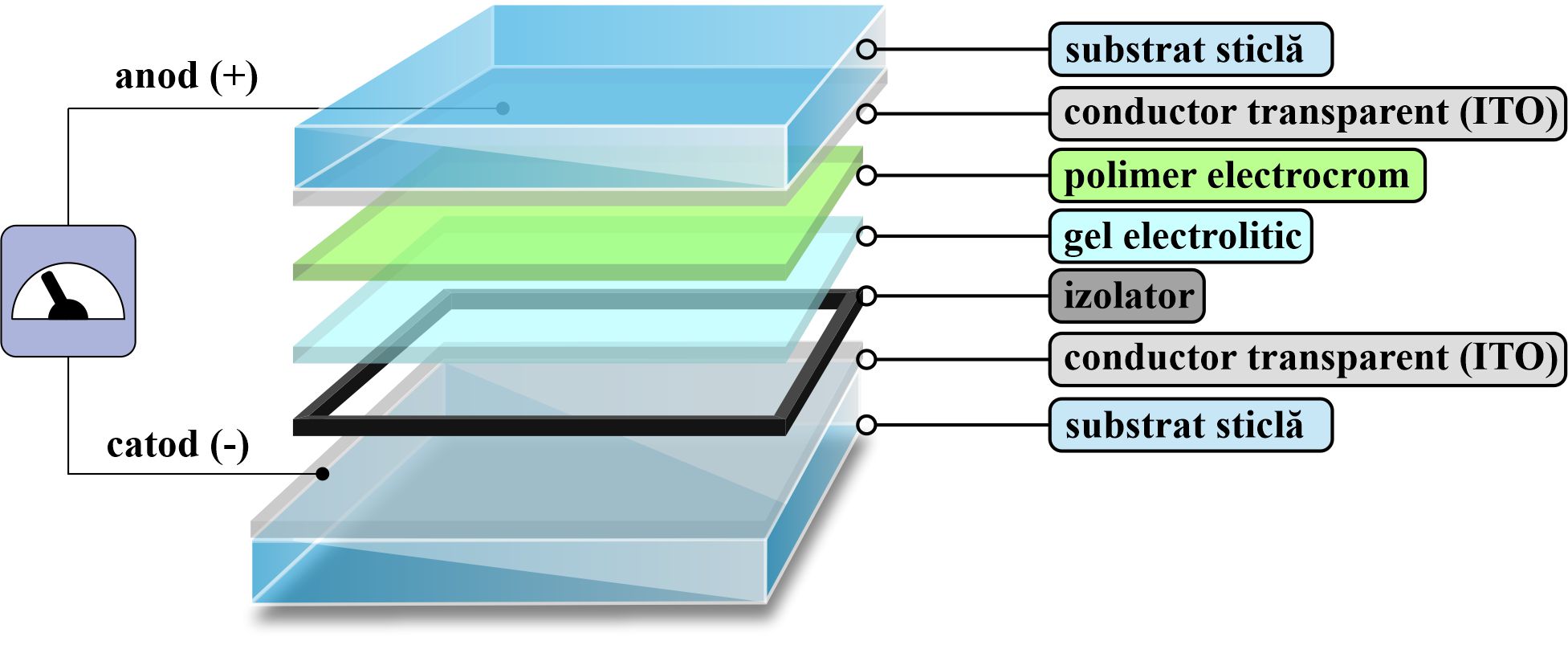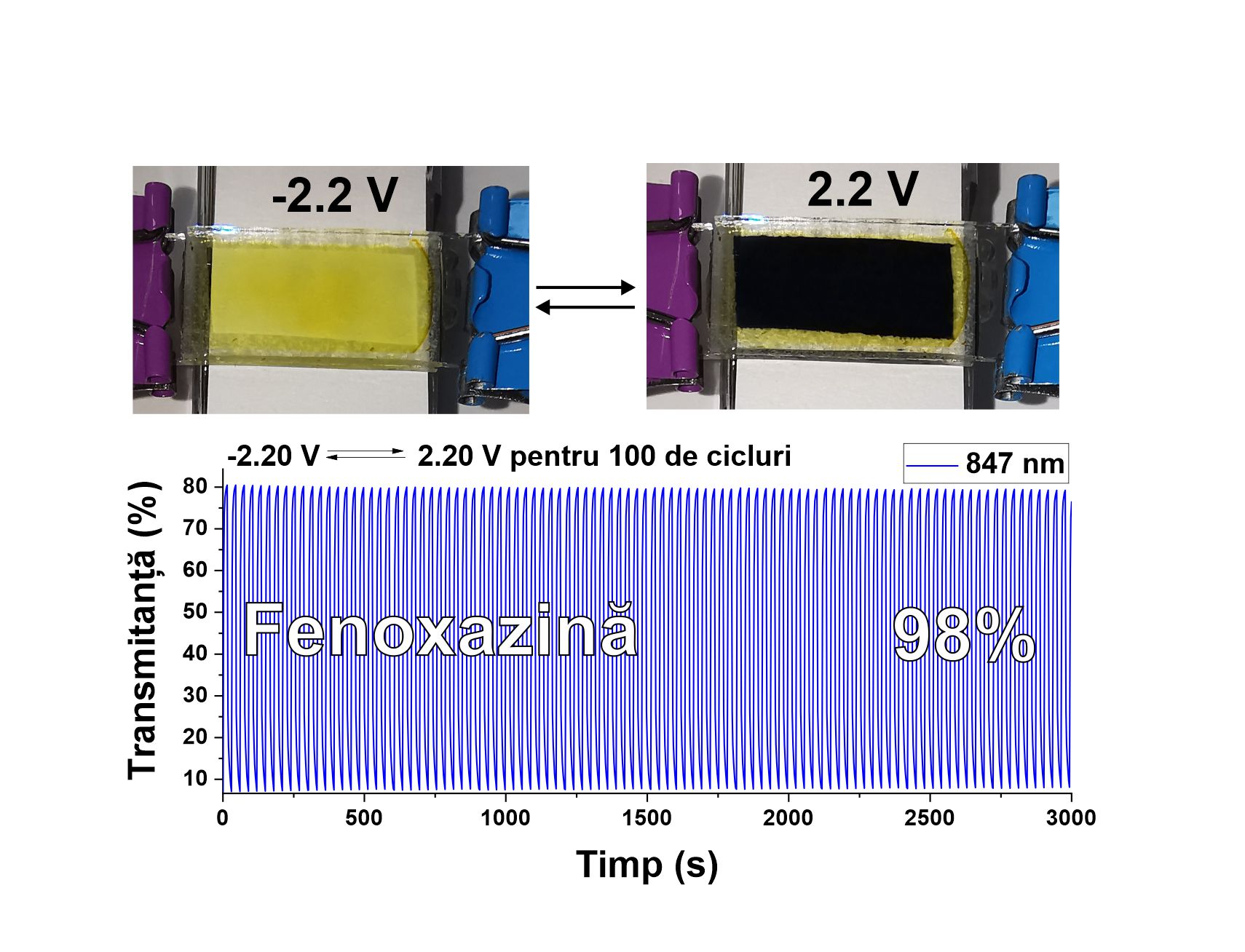⁕ Stage I (2020) and Stage II (2021) - Scientific Report Abstract
In Stage I (2020) and Stage II (2021) of the EngEChrom, 2 new diamines based on phenoxazine (POZ) and 1 based on phenothiazine (PTZ) were synthesized and structurally characterized. These diamines integrate triphenylamine (TPA) into a double electron donor topology to reduce the oxidation potential. The chemical structure of diamines, as well as the intermediates, was confirmed by 1H‒ (proton) and 13C‒ (carbon) NMR (nuclear magnetic resonance) spectroscopy and Fourier Transform infrared spectroscopy (FTIR). Proton and carbon NMR confirmed the structure and a 99% purity. In the proton NMR spectrum, the diamines showed typical signals attributed to the presence of amino groups and other aromatic and aliphatic structural elements that highlighted the presence of POZ and TPA units. The carbon NMR spectrum highlights the amino groups by the presence of the signal at about 145 ppm. Moreover, in the FTIR spectrum, diamine showed the absorption bands characteristic of the amino functional group. Based on them, polymers were synthesized as electroactive layers for prototype EC devices, which were synthesized by the polycondensation reaction to obtain 1 polyimide, 1 polyazomethine and 4 polyamides (6 polymers). These were grouped in two series to evaluate, first and foremost, the most advantageous class of polymers from the physico-chemical and electrochromic point of view, and secondly, the identification of the reaction counterparts from the same class of polymers that would lead to the most advantageous results. The chemical structure of the polymers was confirmed by spectral methods such as proton NMR and FTIR, and the structural elements typical of each class of polymers were identified. The thermal properties of the polymers were evaluated by differential scanning calorimetry (DSC) and thermogravimetric analysis (TGA). The the glass transitions of the polymers were in the temperature range typical of the classes to which they belong. Also, all polymers showed excellent thermal stability, as expected for these classes of polymers. Therefore, the recorded values successfully meet the requirements for using these polymers as electroactive layers in EC devices. The quality and morphology of thin polymer films were studied by scanning electron microscopy (SEM), and the images showed that they were smooth and homogeneous, without cracks or pinholes. Both basic and excited state geometries were obtained by DFT and TD‒DTF, involving the functional B3LYP together with the basic set 6-31 G(d,p), in order to identify the distribution of HOMO and LUMO orbitals and to evidence the main transitions from the experimental UV-Vis spectra. Thus, the n-π* transitions corresponding to the TPA and POZ units were identified, as well as those from two transitions associated with the charge transfer complex (CTC) between the TPA and POZ units and the electron acceptors. Except for polyazomethine, all synthesized polymers showed low absorption in the visible range of the electromagnetic spectrum, making them ideal for EC devices. In the anodic scan, the polymers showed two reversible REDOX waves with excellent stability even after 100 repetitive cycles, corresponding to the oxidation processes of POZ and TPA, respectively. Spectroelectrochemistry measurements have shown the variation of the absorption bands as the potential increased, being associated with the formation of cationic radicals and dicationic species. These spectral changes were also accompanied by the change of the films' color to green and blue. Based on 2 polymers with the best performance and physico-chemical characteristics, 2 EC prototype devices were assembled. The obtained results were rigorously analyzed, the structure-property-efficiency correlations were established, the construction technology of the devices was optimized, and the electrochromic performances and stability were evaluated. The results showed an electrochromic efficiency of up to 312 cm2/C. Also, the recovery of the electrochromic effect of the devices was up to 98% after 100 cycles. The results of Stage I and Stage II of EngEChrom were disseminated by 4 oral presentations and 1 poster at 4 international scientific events, and 2 papers published in ISI-indexed journals. Also, a dedicated web page was created on the official website of the host institution, which offers high visibility and serves as a tool for the dissemination of the results throughout the project.
⁕ Stage III (2022) - Scientific Report Abstract
In Stage III of the EngEChrom project, 1 diamine based on phenothiazine (PTZ) was synthesized and structurally characterized. This diamine integrate triphenylamine (TPA) into a double electron donor topology to reduce the oxidation potential. The chemical structure of diamines, as well as the intermediates, was confirmed by 1H‒ (proton) and 13C‒ (carbon) NMR (nuclear magnetic resonance) spectroscopy and Fourier Transform infrared spectroscopy (FTIR). Proton and carbon NMR confirmed the structure and a purity of 98%. In the proton NMR spectrum, the diamine showed typical signals attributed to the presence of amino groups (at around 4.5 ppm) and other aromatic and aliphatic structural elements that highlighted the presence of PTZ and TPA units. The carbon NMR spectrum highlights the amino groups by the presence of the signal at about 145 ppm. Moreover, in the FTIR spectrum, diamine showed the absorption bands characteristic of the amino functional group. Based on them, polymers were synthesized as electroactive layers for prototype EC devices, which were synthesized by the polycondensation reaction to obtain 1 polyimide, 1 polyazomethine and 4 polyamides (6 polymers). These were grouped into tow series with the aim: (i) to identify the most advantageous class of polymers from a physico-chemical and electrochromic point of view and (ii) to identify the reaction counterparts from the same type of polymers that would lead to the most advantageous results. The chemical structure of the polymers was confirmed by spectral methods such as proton NMR and FTIR, and the structural elements typical of each class of polymers were identified. The thermal properties of the polymers were evaluated by differential scanning calorimetry (DSC) and thermogravimetric analysis (TGA). The values of the glass transitions of the polymers were in the temperature range typical of the classes to which they belong. Also, all polymers shown excellent thermal stability, as expected for these classes of polymers. Therefore, the recorded values successfully meet the requirements for using these polymers as electroactive layers in EC devices. The quality and morphology of thin polymer films were studied by scanning electron microscopy (SEM), and the images showed that they were smooth and homogeneous, without cracks or pinholes. Both ground and excited state geometries were obtained by DFT and TD‒DTF, involving the functional B3LYP together with the basic set 6-31G++(d,p), in order to identify the distribution of HOMO and LUMO orbitals and to evidence the main transitions from the experimental UV-Vis spectra. Thus, the n-π * transitions corresponding to the TPA PTZ and POZ units were identified, as well as those from two transitions associated with the charge transfer complex (CTC) between the TPA and POZ/PTZ units and the electron acceptors. Except for polyazomethines, all synthesized polymers showed low absorption in the visible range of the electromagnetic spectrum, making them ideal for EC devices. In anodic scanning, the polymers showed two reversible REDOX waves with excellent stability even after 100 repetitive cycles, corresponding to the oxidation processes of POZ, PTZ and TPA, respectively. Spectroelectrochemistry measurements showed the variation of the absorption bands as the potential increased, being associated with the formation of cationic radicals and dicationic species. These spectral changes were also accompanied by the change of the films' color to green and blue. Based on 2 polymers with the best performance and physico-chemical characteristics, 2 EC prototype devices were assembled. The obtained results were rigorously analyzed, the structure-property-efficiency correlations were established, the construction technology of the devices was optimized, and the electrochromic performances and stability were evaluated. The devices showed an electrochromic efficiency of up to 209 cm2/C. Also, the recovery of the electrochromic effect of the devices was up to 96% after 100 cycles. The results of Stage III of EngEChrom project were disseminated by 2 oral presentations and 1 poster at 2 international scientific events, and 3 papers published in ISI-indexed journals and 1 patent application submitted to OSIM. The rigorous analysis of all the results generated during this project, as well as a result of the discussions and conclusions were drawn at the workshop which was held at the end of the project with the participation of the members of the implementation team. The dedicated web page on the official website of the host institution, offered high visibility and served as a tool for the dissemination of the results throughout the project.
⁕ Final Report - Scientific Report Abstract
In EngEChrom project, 2 diamines based on phenoxazine (POZ) and 2 based on phenothiazine (PTZ) were synthesized and structurally characterized. These diamines integrate triphenylamine (TPA) into a double electron donor topology to reduce the oxidation potential. The chemical structure of diamines, as well as the intermediates, was confirmed by 1H‒ (proton) and 13C‒ (carbon) NMR (nuclear magnetic resonance) spectroscopy and Fourier Transform infrared spectroscopy (FTIR). Proton and carbon NMR confirmed the structure and a purity of 99% . In the proton NMR spectrum, the diamines showed typical signals attributed to the presence of amino groups (at around 4.5 ppm) and other aromatic and aliphatic structural elements that highlighted the presence of POZ, PTZ and TPA units. The carbon NMR spectrum highlights the amino groups by the presence of the signal at about 145 ppm. Moreover, in the FTIR spectrum, the diamines showed the absorption bands characteristic of the amino functional group. Based on them, polymers were synthesized as electroactive layers for prototype EC devices, which were synthesized by the polycondensation reaction to obtain 2 polyimides, 2 polyazomethines and 8 polyamides (12 polymers). These were grouped into four series with the aim: (i) to identify the structural unit (POZ or PTZ) that would induces the lowest value of the oxidation potential of polymers; (ii) to identify the most advantageous class of polymers from a physico-chemical and electrochromic point of view; (iii) to identify the reaction counterparts from the same type of polymers that would lead to the most advantageous results. The chemical structure of the polymers was confirmed by spectral methods such as proton NMR and FTIR, and the structural elements typical of each class of polymers were identified. The thermal properties of the polymers were evaluated by differential scanning calorimetry (DSC) and thermogravimetric analysis (TGA). The values of the glass transitions of the polymers were in the temperature range typical of the classes to which they belong. Also, all polymers shown excellent thermal stability, as expected for these classes of polymers. Therefore, the recorded values successfully meet the requirements for using these polymers as electroactive layers in EC devices. The quality and morphology of thin polymer films were studied by scanning electron microscopy (SEM), and the images showed that they were smooth and homogeneous, without cracks or pinholes. Both ground and excited state geometries were obtained by DFT and TD‒DTF, involving the functional B3LYP together with the basic set 6-31G++(d,p), in order to identify the distribution of HOMO and LUMO orbitals and to evidence the main transitions from the experimental UV-Vis spectra. Thus, the n-π * transitions corresponding to the TPA PTZ and POZ units were identified, as well as those from two transitions associated with the charge transfer complex (CTC) between the TPA and POZ/PTZ units and the electron acceptors. Except for polyazomethines, all synthesized polymers showed low absorption in the visible range of the electromagnetic spectrum, making them ideal for EC devices. In anodic scanning, the polymers showed two reversible REDOX waves with excellent stability even after 100 repetitive cycles, corresponding to the oxidation processes of POZ, PTZ and TPA, respectively. Spectroelectrochemistry measurements showed the variation of the absorption bands as the potential increased, being associated with the formation of cationic radicals and dicationic species. These spectral changes were also accompanied by the change of the films' color to green and blue. Based on 4 polymers (2 based on POZ and 2 based on PTZ) with the best performance and physico-chemical characteristics, 4 EC prototype devices were assembled. The obtained results were rigorously analyzed, the structure-property-efficiency correlations were established, the construction technology of the devices was optimized, and the electrochromic performances and stability were evaluated. The devices showed an electrochromic efficiency of up to 312 cm2/C, in the case of POZ-based polymers, and 209 cm2/C in the case of PTZ-based polymers, respectively. Also, the recovery of the electrochromic effect of the devices was up to 98% in the case of POZ-based polymers, and 96% in the case of PTZ-based polymers after 100 cycles. The results of EngEChrom project were disseminated by 6 oral presentations and 2 poster at 4 international scientific events, and 5 papers published in ISI-indexed journals, with an impact factor between 3.407 and 7.613 and 1 patent application submitted to OSIM. The Final Project Report was drafted following the rigorous analysis of all the results generated during this project, as well as a result of the discussions and conclusions drawn at the workshop held at the end of the project with the participation of the members of the implementation team. This also includes the future research directions drawn on the EngEChrom project theme. The dedicated web page on the official website of the host institution, offered high visibility and served as a tool for the dissemination of the results throughout the project.
⁕ Publications
2020 − 2021
- Catalin-Paul Constantin,* Gabriela Lisa, and Mariana-Dana Damaceanu. Assessing the Electrical Characteristics of p−n Heterojunction Prototype Diodes Realized with n‑Type Polyimide Materials. Macromolecules, 54, 941−957 (2021) https://doi.org/10.1021/acs.macromol.0c01853.
- Catalin-Paul Constantin, Mihai Asandulesa, Cristian Varganici, Violeta Melinte, Maria Bruma, Andrzej Jankowski, Aleksandra Wolinska-Grabczyk, Mariana-Dana Damaceanu*. Exploring the potential of thin films made from poly(imide-amide-sulfone)s for engineering applications. Mater. Sci. Eng., B, 270, 115217 (2021).
https://doi.org/10.1016/j.mseb.2021.115217
2022
- I. Butnaru, A. P. Chiriac, C. P. Constantin, M. D. Damaceanu*. Insights into MWCNTs/polyimide nanocomposites: from synthesis to application as free-standing flexible electrodes in low-cost micro-supercapacitors. Mater. Today Chem., 23, 100671 (2022). https://doi.org/10.1016/j.mtchem.2021.100671
- C. P. Constantin*, M. D. Damaceanu, M. Mihaila, M. Kusko. Open circuit voltage degradation by dye Mulliken electronegativity in multi-anchor organic dye-based DSSCs.
ACS Appl. Energy Mater., 5, 7600–7616 (2022).
https://doi.org/10.1021/acsaem.2c01059
- A. E. Bejan, C. P. Constantin*, M. D. Damaceanu. Evidence of diimide structure variation on overall performance of electro(fluoro)chromic devices integrating versatile triphenylamine-based polyimides. Mater. Today Chem., 26, 101100 (2022).
https://doi.org/10.1016/j.mtchem.2022.101100
⁕ Conferences
2020 – 2021
- Catalin-Paul Constantin*, Andra-Elena Bejan, Mariana-Dana Damaceanu. Synthesis and characterization of new triphenylamine-based polyimides for electrochromic applications. 2nd Bucharest Polymer Conference Bucharest (BPC2020), June 9-11, 2021, Bucharest, Romania.
- Irina Butnaru*, Catalin-Paul Constantin, Mariana-Dana Damaceanu. Polyimides containing bipyridyl-amine functionalized triphenylamine as electrochromic materials. 13th International Conference on Physics of Advanced Materials (ICPAM-13), September 24 – 30, 2021, Sant Feliu de Guixols, Spania.
- Catalin-Paul Constantin*, Andra-Elena Bejan, Mariana-Dana Damaceanu. Effect of dianhydride segment structure on the electrochromic properties of novel triphenylamine-based polyimides. New trends and strategies in the chemistry of advanced materials with relevance in biological systems, technique and environmental protection, 13th Edition, online, October 7 – 8, 2021, Timisoara, Romania.
- Mariana-Dana Damaceanu*, Catalin-Paul Constantin, Andra-Elena Bejan, Cristian Logigan. Recent concepts in electrochromic polymers containing triarylamine as electroactive unit. Progress in Organic and Macromolecular Compounds, 28th Edition, International Conference, October 7 – 9, 2021, Iasi, Romania.
2022
- M. D. Damaceanu*, C. P. Constantin. New trends in triphenylamine-based polymers for less-energy intensive electrochromic devices. 14th International Conference on Physics of Advanced Materials (ICPAM-14), September 8 – 15, 2022, Dubrovnik, Croatia.
- C. P. Constantin*, R. D. Rusu, M. D. Damaceanu. Electrochromic polyamides featuring triphenylamine moiety modified with methyl and trifluoromethyl groups,
14th International Conference on Physics of Advanced Materials (ICPAM-14), September 8 – 15, 2022, Dubrovnik, Croatia.
⁕ Posters
2020 – 2021
- Catalin-Paul Constantin*, Andra-Elena Bejan, Mariana-Dana Damaceanu. Electrochromic prototype devices based on triphenylamine-triphenylmethane containing polyimides. 13th International Conference on Physics of Advanced Materials (ICPAM-13), September 24 – 30, 2021, Sant Feliu de Guixols, Spania.
2022
- C. P. Constantin*, A. E. Bejan, M. D. Damaceanu. Tuning the electrochromic performances of novel triphenylamine-based polyimides by polymer backbone variation.
1st Baltic Symposium on Polymer and (Bio) Materials Science (Baltic BioMat), September 22 – 23 Szczecin, Polonia.
⁕ Prezentare succintă a rezultatelor obținute în cadrul proiectului EngEChrom
Asigurarea necesarului de energie și reducerea contribuției energetice la schimbările climatice sunt cele două provocări principale ale sectorului energetic către un viitor sustenabil. De-a lungul anilor, dezvoltarea durabilă a devenit centrul politicilor, strategiilor și planurilor de dezvoltare naționale ale multor țări. Cercetările privind conceptul de eficiență energetică și sursele alternative de energie datează de la sfârșitul anilor 90, în contextul încălzirii globale. Prin urmare, proiectul s-a aliniat temelor de cercetare foarte importante – „Energie” și „Materiale avansate”, din domeniile tematice ale HORIZON EUROPĂ, Pilonul II. Prin urmare, obiectivul principal al acestui proiect de cercetare, intitulat “Ingineria de ultimă generație a unor dispozitive electrocrome polimerice cu funcționare la tensiune joasă destinate economisirii de energie” ‒ EngEChrom, a fost de a dezvolta noi materiale polimerice pentru a fi utilizate ca straturi active în prototipuri de dispozitive electrocrome eficiente din punct de vedere energetic.
În timp ce interesul pentru materialele polimerice ca straturi active în dispozitive electrocrome este în creștere, rezultatele obținute în cadrul proiectului se încadrează într-un domeniu care este insuficient explorat în România. Acești polimeri ar permite diversificarea gamei de materiale pentru aplicații de înaltă performanță. Comercializarea lor ar putea fi, dimpotrivă, catalizată de creșterea unei game de companii start-up și spin-off, poate declanșată de succesele cercetării din sectorul academic.
Rezultatele proiectului pot ajuta la dezvoltarea științelor fundamentale, cât și a aplicațiilor industriale. De asemenea, pot contribui la îmbunătățirea calității vieții prin dezvoltarea, difuzarea și preluarea de noi materiale polimerice cu utilizare în dispozitive electrocrome (ex. ferestre inteligente). Astfel de dispozitive pot avea un impact pozitiv asupra vieții noastre de zi cu zi datorită versatilității lor de a aborda mai multe domenii aplicative simultan. Prin urmare, prin finanțarea ce a primit-o acest proiect, România ar putea fi recunoscută printre țările cu preocupări științifice avansate.
 
|








